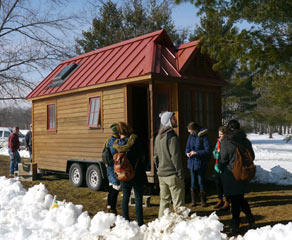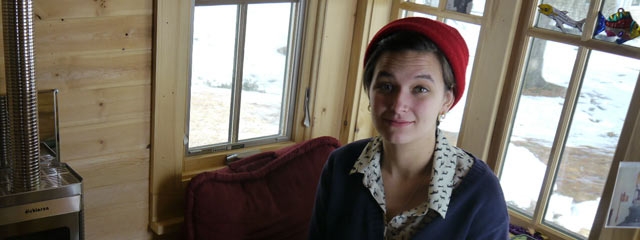Div III Nara Williams’ Sustainability Experiment
Like most Hampshire students, Nara Williams 09F is creative, bold about putting her ideas into action, and concerned about living in an environmentally responsible manner. Her academic work focuses on literary journalism and sustainability.
All those traits and interests have come together this spring in an enterprising Division III project: Williams is spending her final semester at Hampshire living in a 130-square-foot tiny house that she had moved onto campus.
How she came to live in the tiny house (and pretty much for free) is a story that begins with her academic work. For her final project, she is writing a series of thoughtful essays examining aspects of natural and built environments. One point she’s exploring is how housing choices can isolate people and remove them from the natural world. She’s looking at models that might help us live closer to nature, including the tiny house. “With less space, you do tend to get outside more,” she says.
During fall semester Williams reached out to the Tumbleweed Tiny House Company in Sonoma, California, sharing a bit of her writing. After some back-and-forth exchanges, and to her great surprise, the company extended the offer of a tiny house that she could live in and blog about while still a student — plus a job after she graduates in May. The goal is for her to help Tumbleweed expand its East Coast presence as well as build awareness about the advantages of tiny house living.
 Williams paid the delivery costs ($1,800), but otherwise Tumbleweed is letting her use the tiny house at no charge in exchange for the visibility she’s bringing to the benefits of living simply.
Williams paid the delivery costs ($1,800), but otherwise Tumbleweed is letting her use the tiny house at no charge in exchange for the visibility she’s bringing to the benefits of living simply.
As is true of many people in the growing tiny house movement, Williams has been influenced by learning about the mortgage crisis of recent years, especially after reading about the loss of homes by people who might have been able to hold onto smaller spaces. Growing up in suburban Chicago, she often wondered why people needed or wanted large, three-story homes. “I think it’s important to start out in a different way,” she says. “I really want to encourage people to rethink that model.”
The faculty committee for her Division III includes writing program co-director Deb Gorlin and anthropology professor Sue Darlington. She also worked with other staff and officials at Hampshire to arrange for the tiny house living experiment to be integrated into her final academic project. Hampshire’s facilities and grounds crew, whom she lauds as “superheroes,” assisted in leveling the area and setting up the house when it was delivered.
The delivery itself didn’t go quite as smoothly as planned, with delays caused by both blizzards and black ice. But once the tiny house arrived on February 15 from Wisconsin, where it had been a display model, Williams moved in. Since then, she’s been busy not only with research and writing, but also with hosting a stream of campus visitors wanting to check out her new place.
The tiny house has a cabin-like feel, with an open, wood-paneled living space, kitchen, and sleeping loft. It smells wonderful, thanks to all the unfinished pine. A propane fireplace provides warmth, and should Williams need it before her May graduation there is also a built-in air conditioner.
Boston Globe story >>
Inside Higher Ed Guest Post: Nara Williams on Her Tiny House >>
New England Public Radio’s Morning Edition Extra >>
Read about it in her own words: Nara Williams blogs about her Tiny Semester >>
Switchboard Magazine video profile:






Pingback: Living Large in a Tiny House | Family Relations Blog | Hampshire College’s blog for families of new, current, and past students
Neat-o!
This post has been featured in the GOLDEN KNOB AWARDS:
https://www.knobs.co/top-tiny-house-blogs
Congratulations and keep up the awesome work!